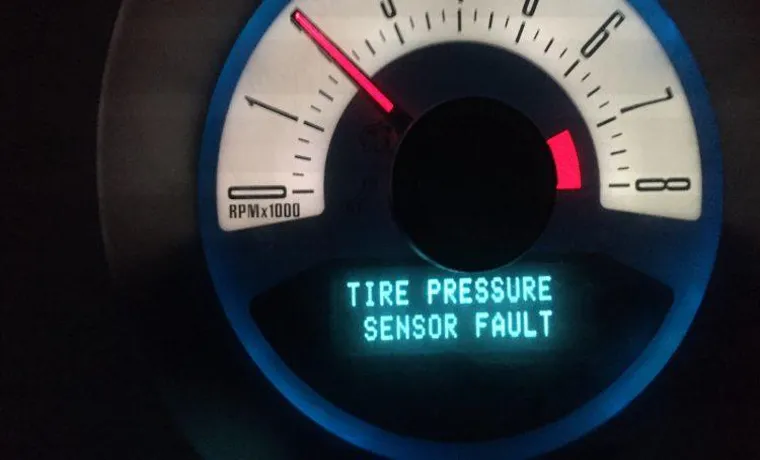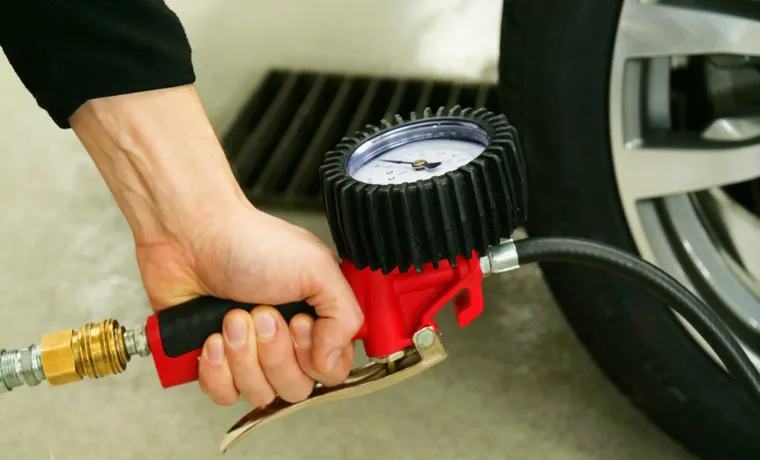Keeping your vehicle running smoothly is crucial, and one of the most important aspects of that is checking your tire pressure regularly. However, even when you do everything right with your tire pressure, sometimes you may still run into issues with your tire pressure sensor fault. When this happens, it can be confusing and frustrating, especially if you’re not sure how to fix it.
Thankfully, there are lots of steps you can take to get your tire pressure sensor back on track, from checking the battery to ensuring the valve stems are in good condition. With those simple tricks in your arsenal, you can make sure your vehicle stays safe and well-maintained for years to come.
Table of Contents
Understanding Tire Pressure Sensor
If you’re experiencing a tire pressure sensor fault, don’t panic! It’s an issue that can easily be fixed. First things first, it’s essential to understand that the tire pressure sensor is an integral part of your car’s safety features that monitor the air pressure in your vehicle’s tires. Low tire pressure can cause decreased fuel efficiency, uneven wear on your tires, and, in rare cases, can lead to a blowout.
So, it’s vital to take this issue seriously. One of the reasons for the tire pressure sensor fault is a low battery level. The sensors use a battery to function, and if it’s low, it can trigger the sensor’s malfunction.
Thus, to remedy the issue, it might only need a battery replacement. However, there might be other reasons for the sensor’s malfunction, like a faulty sensor, or a blown fuse. Checking all these other factors will help you fix the tire pressure sensor fault and ensure your car’s safety on the road.
What is it?
Tire Pressure Sensor Tire pressure sensors are an essential component that ensures your car runs smoothly and safely. These sensors provide the user with real-time information about the air pressure inside each tire of the car. By monitoring tire pressure, the sensors can notify the driver when the pressure is too low or too high.
Maintaining optimum tire pressure is critical as it ensures the vehicle’s stability, handling, and fuel efficiency. Tire pressure sensors can save you money on fuel costs and prevent accidents caused by underinflated tires. The sensors operate using radio frequency and battery power and require little to no maintenance as they are typically designed to last for the life of the tire.
With proper installation and calibration, tire pressure sensors can provide excellent performance and peace of mind for the driver. So, if you value your safety and the longevity of your car, ensure you regularly check your tire pressure and invest in a tire pressure sensor.

Importance of Tire Pressure Sensor
Have you ever wondered why your car has a tire pressure sensor? Well, it’s for your safety! Understanding how your tire pressure sensor works can make a big difference in the longevity and safety of your vehicle. This small but mighty sensor continuously measures the air pressure in your tires and alerts you when they are below the recommended level. This is important because underinflated tires can affect your vehicle’s handling and braking, leading to unsafe driving conditions.
In addition, low tire pressure can decrease fuel efficiency and increase tire wear, ultimately costing you more money in the long run. Therefore, it’s essential to regularly check your tires’ pressure and take heed of your tire pressure sensor’s warnings. By doing so, you can ensure that your vehicle is running safely and efficiently, preventing costly repairs and accidents on the road.
Symptoms of Faulty Tire Pressure Sensor
If you experience frequent tire pressure warnings from your vehicle’s dashboard, it may be due to a faulty tire pressure sensor. Other symptoms such as fluctuating tire pressure readings or consistently low readings can also indicate a malfunctioning sensor. The good news is that fixing the tire pressure sensor fault is typically not difficult.
The first step is to ensure that all four tires have the correct pressure levels. Then, try resetting the tire pressure monitoring system to see if the sensor recalibrates itself. If these steps don’t work, it may be necessary to replace the sensor altogether.
In any case, it’s crucial to address a faulty tire pressure sensor promptly to avoid potentially dangerous situations on the road. By staying on top of routine maintenance tasks, including checking tire pressure, you can help ensure that your vehicle stays running smoothly.
Low Tire Pressure warning
If you’ve ever seen the dreaded “Low Tire Pressure” warning light pop up on your dashboard, then you know just how important it is to have properly functioning tire pressure sensors. These sensors are a crucial component of your vehicle’s safety system, as they keep you alerted to any changes in your tire pressure. However, if your tire pressure sensor is faulty, it can lead to a number of frustrating symptoms.
For example, you may notice that your tires seem to be losing air more often than usual, or you may get false low-pressure warnings even when your tires are perfectly fine. In some cases, a faulty sensor can even cause your tires to wear unevenly, which can lead to dangerous driving conditions and a shorter lifespan for your tires. To ensure the safety and proper function of your vehicle, it’s important to look out for these symptoms and get your tire pressure sensor checked and repaired if necessary.
Erratic Reading
If you’ve ever had a tire pressure warning light come on sporadically, then you may have experienced a faulty tire pressure sensor. These sensors are responsible for detecting changes in the air pressure within your tires and transmitting that information to your vehicle’s computer system. When they malfunction, you may notice erratic readings, such as sudden drops or increases in tire pressure, or false alarms indicating that one of your tires is low on air.
It’s important to get this issue checked out by a professional, as driving with incorrect tire pressure can lead to decreased fuel efficiency, poor handling, and a higher risk of blowouts. Keep an eye out for signs of a faulty tire pressure sensor, such as inconsistent readings or a persistent warning light, and schedule a check-up as soon as possible to ensure your safety on the road.
Other Indicators
Along with the tire pressure warning light, there are other indicators that may signal a faulty tire pressure sensor. One of the most common symptoms is the continued illumination of the warning light even after the tire pressure has been corrected. This could be due to a malfunctioning sensor that is unable to accurately measure the tire pressure.
In addition, a faulty tire pressure sensor may also trigger the anti-lock brake system (ABS) light or the traction control system (TCS) light, as it can send incorrect information to these systems. Another indicator of a problematic sensor is a sudden drop or increase in fuel efficiency, as the vehicle’s computer can adjust the air-to-fuel mixture based on incorrect tire pressure data. If you notice any of these symptoms, it is important to have your tire pressure sensor inspected by a qualified mechanic to avoid potential safety issues on the road.
Steps to Fix Tire Pressure Sensor Fault
If you’re experiencing issues with your tire pressure sensor, don’t worry, it’s a common problem that can be fixed. The first step is to check the tire pressure manually. If the pressure is too high or too low, adjust it accordingly and check the sensor again.
If the problem persists, try resetting the sensor by following the instructions in your owner’s manual. In some cases, the sensor may need to be recalibrated by a professional mechanic. It’s important to address any issues with your tire pressure sensor as soon as possible since low tire pressure can impact your vehicle’s performance and even lead to a dangerous blowout.
So, don’t wait – take these steps to fix your tire pressure sensor fault and stay safe on the road.
Resetting the System
A tire pressure sensor fault can be aggravating, as it can potentially mess with the performance of your vehicle. Luckily, there are a few simple steps that you can take to reset the system and fix the issue. Firstly, make sure that your tire pressure is properly set.
You can do this by checking the recommended pressure level for your specific vehicle and then using a tire gauge to measure each tire’s pressure level. Next, locate the reset button for the tire pressure monitoring system. This button can usually be found beneath the steering wheel.
Then, press and hold the button until the light on your dashboard blinks a few times, signifying that the system has been reset. This should do the trick and clear any faults that your tire pressure sensor was displaying. If this still doesn’t work, it may be time to take your vehicle to a mechanic or dealer to get the issue resolved.
Remember, keeping up with regular tire pressure checks and maintenance can help prevent any further problems with your tire pressure sensor.
Replacing the Faulty Sensor
If you’re experiencing issues with your tire pressure sensor, don’t panic – replacing a faulty sensor is a relatively simple process that you can perform yourself. The first step is to locate the problematic sensor. You can usually identify the specific sensor that’s causing the problem by checking the dash warning light or using a tire pressure monitoring system tool.
Once you’ve identified the faulty sensor, you’ll need to remove the tire from the vehicle and take the sensor out of the valve stem. After that, all you need to do is replace the old sensor with a new one, making sure to tighten it properly using a torque wrench. Finally, re-inflate the tire to the manufacturer’s recommended pressure and you’re done! With these straightforward steps, you’ll be able to fix your tire pressure sensor fault in no time, ensuring that your vehicle is safe and reliable on the road again.
Seek Professional Help
If you’re experiencing a tire pressure sensor fault, the first step you should take is to seek professional help. While it may be tempting to try and fix the issue yourself, a faulty sensor can lead to significant safety risks if left unaddressed. To start resolving the problem, take your car to a licensed mechanic or dealership.
They have the knowledge and tools necessary to diagnose and repair the issue correctly. By opting for professional assistance, you can rest assured that the problem will be resolved correctly and in a timely manner. Remember, your safety is critical, and it’s best to seek expert help whenever you encounter a problem with your vehicle.
So don’t hesitate to book an appointment with a qualified technician to get your tire pressure sensors back in proper working order.
Maintaining Tire Pressure Sensor
If you’re experiencing a tire pressure sensor fault, fixing it may not be as complicated as you think. The first step is to check the tire pressures manually with a gauge and compare them to the recommended pressure levels stated in your vehicle’s manual or on the door jamb sticker. If the pressure is too low, add air until it matches the recommended level.
If the pressure is too high, release air until it matches. After adjusting the tire pressures, turn on your vehicle and drive it until the dashboard light indicating a low tire goes off. If it still doesn’t turn off, you may need to reset the sensor using your vehicle’s specific procedure outlined in the manual.
In some cases, the sensor may have been damaged or require replacement. Keep in mind that maintaining proper tire pressure not only improves fuel efficiency but also extends the life of your tires. So, always ensure to check tire pressures routinely.
Regular Check-Up
Maintaining your tire pressure sensor is essential to ensure that your vehicle runs efficiently. Regular check-ups are necessary to keep your car in top condition. Incorrect tire pressure can cause a decrease in fuel efficiency and can lead to uneven wear and tear on your tires.
A well-maintained tire pressure sensor can help prevent issues on the road and keep you safe while you’re driving. To maintain your tire pressure sensor, be sure to check your tire pressure regularly and adjust it as needed. Your owner’s manual should provide you with the correct pressure levels for your tires.
Many newer vehicles have a tire pressure monitoring system that will let you know if your tire pressure drops below a certain level. If your car has this feature, you should still check your tire pressure manually on a regular basis. It’s important to remember that drastic changes in temperature can also affect your tire pressure.
As the temperature drops, your tires will lose pressure, so it’s a good idea to check them more frequently during colder months. When checking your tire pressure, be sure to inspect the valve stem and any caps to ensure they are not damaged or missing. In conclusion, maintaining your tire pressure sensor is critical for ensuring your vehicle is running smoothly.
Regular check-ups can help catch issues before they become problems and can extend the life of your tires. Take the time to check your tire pressure regularly and adjust it as needed. Your car will thank you for it.
Avoiding Mechanical Stress
Maintaining the tire pressure sensor is of utmost importance when it comes to avoiding mechanical stress. The tire pressure sensor is responsible for measuring the air pressure inside the tire and transmitting the data to the vehicle’s computer. To keep it working effectively, make sure to check the tire pressure regularly and inflate the tires as necessary.
Low pressure in the tires can damage the pressure sensor, leading to inaccurate readings and even failure. It’s also important to avoid hitting curbs or driving on rough terrain, as this can cause physical damage to the pressure sensor. Just like how regularly visiting the doctor can help prevent serious health issues, taking care of your tire pressure sensor can prevent costly repairs down the road.
Don’t neglect this important component of your vehicle’s safety system.
Conclusion
So there you have it, dear reader. Fixing a tire pressure sensor fault may seem like a daunting task, but it’s actually quite simple. Just follow these easy steps: check the pressure in all of your tires, ensure that the sensors are properly connected, and reset the system.
And if all else fails, remember the advice of the famous philosopher, Timon of Athens, who said, ‘The remedy is worse than the disease.’ So, don’t be afraid to seek help from a professional if you need it. Your safety on the road is worth it!”
FAQs
What are the signs of a faulty tire pressure sensor?
The signs of a faulty tire pressure sensor include a blinking TPMS warning light on the dashboard, inconsistent or inaccurate tire pressure readings, and reduced fuel efficiency.
Can a tire pressure sensor be repaired or does it need to be replaced?
In most cases, a faulty tire pressure sensor cannot be repaired and needs to be replaced. It is important to have it checked and replaced by a qualified mechanic to ensure proper functioning.
How often should tire pressure sensors be replaced?
Tire pressure sensors can last for several years, however, they may need to be replaced if they become damaged or faulty. It is recommended to have them checked during routine maintenance and replaced as needed.
Can a low tire pressure cause a tire pressure sensor fault?
Yes, low tire pressure can cause a tire pressure sensor fault. It is important to regularly check and maintain proper tire pressure to avoid potential damage to the sensors.
Can a tire pressure sensor fault affect the vehicle’s performance?
A tire pressure sensor fault may not directly affect the vehicle’s performance, but it can impact the accuracy of the tire pressure readings and potentially lead to issues with the tires and overall safety.
Can a tire pressure sensor fault be reset manually?
In some cases, a tire pressure sensor fault can be reset manually by adjusting the tire pressure to the proper level and following specific steps outlined in the vehicle’s user manual. However, it is recommended to have it checked by a mechanic to ensure proper functioning.
How much does it typically cost to replace a faulty tire pressure sensor?
The cost to replace a faulty tire pressure sensor can vary depending on the make and model of the vehicle. On average, the cost can range from $50 to $250 per sensor. It is recommended to get an estimate from a qualified mechanic.



